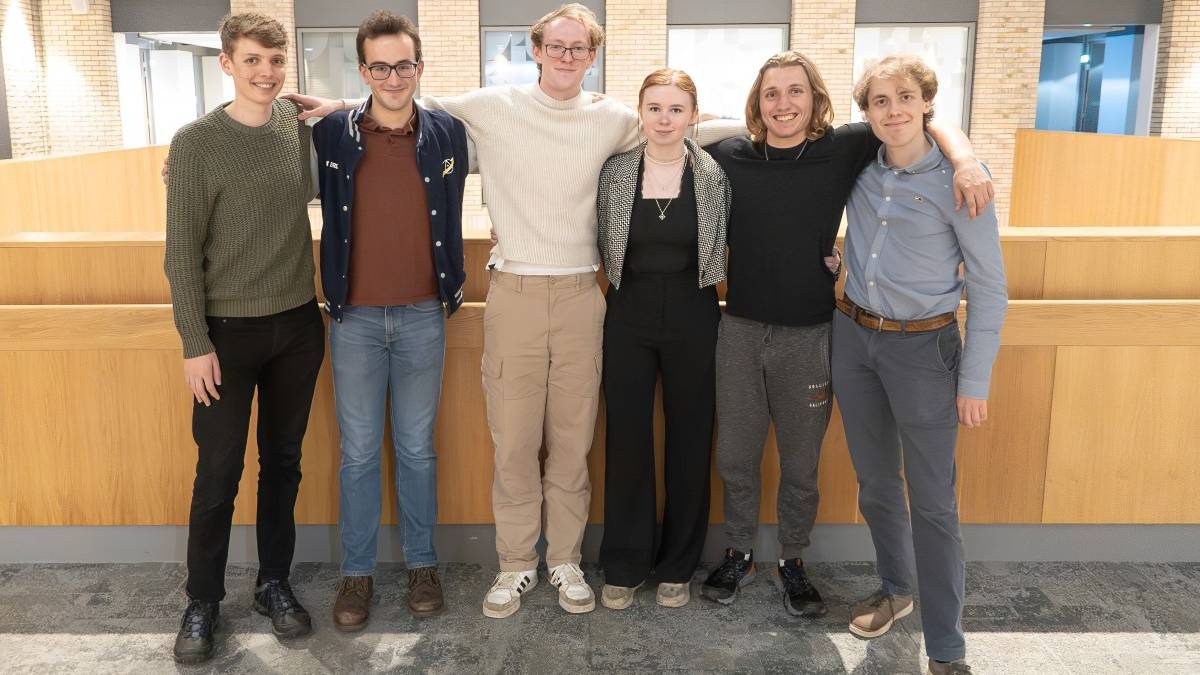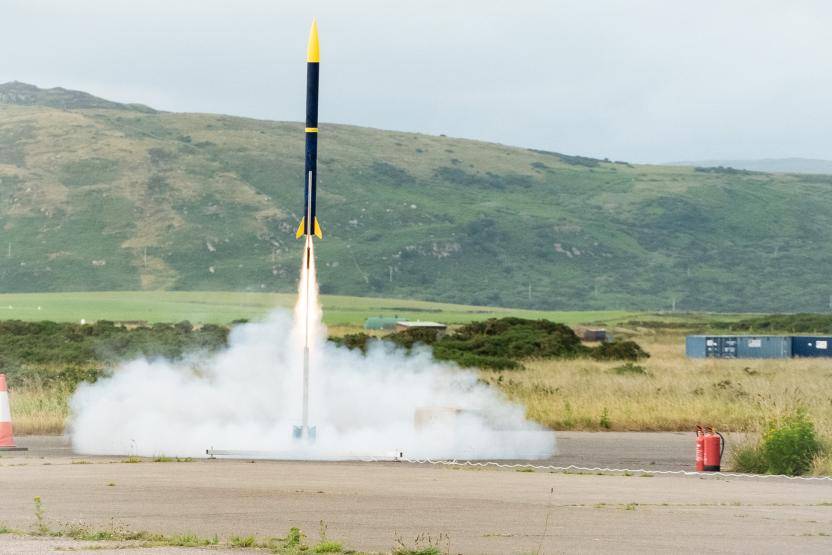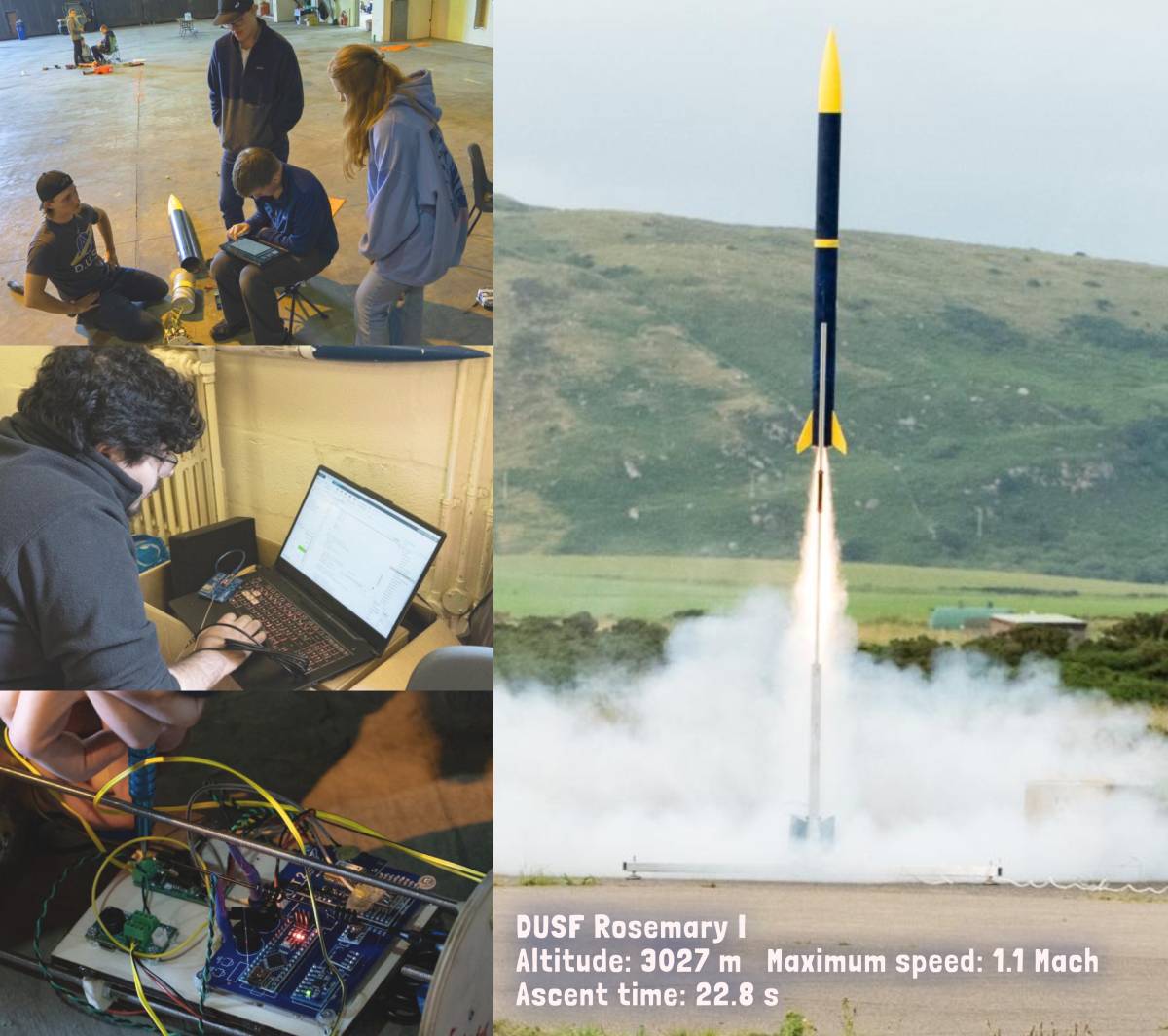 This photo shows members of the Durham University Spaceflight Society who are scheduled to attend and compete in the Space Port America Cup from June 17-22. From left to right: Josh Pine, Fin Brown, Alex Walker, Isabelle Crossley, Alex Kessell-Holland and Timofei Zavileiskii. (Source: Durham University Spaceflight Society)
This photo shows members of the Durham University Spaceflight Society who are scheduled to attend and compete in the Space Port America Cup from June 17-22. From left to right: Josh Pine, Fin Brown, Alex Walker, Isabelle Crossley, Alex Kessell-Holland and Timofei Zavileiskii. (Source: Durham University Spaceflight Society)
CLEVELAND — Isabelle Crossley was always interested in rockets. In fact, the now-president of the Durham University Spaceflight Society gives a lot of credit to one of her teachers for helping ignite her passion. “I had a really inspirational physics teacher and he got me into all things space and rocketry related,” Crossley said. “Shortly after that, I entered a competition called UK Roc and from the second I saw my first model rocket launch, I was hooked.”
In addition to finishing up her degree, Crossley is part of a 50-person team that dedicates a lot of time fueling their love for rockets. While it’s easier to participate in local or regional events, Crossley said for years the team focused on one particular challenge: taking part in the world’s biggest intercollegiate rocket engineering competition, the Spaceport America Cup.
“From the very beginning, as soon as you start looking into model rocketry you find out about this competition. But being from the UK, it’s quite hard to reach,” said Alexander Walker, a fellow teammate and the Head of Rocketry for the Spaceflight Society. “This is our first time entering so for us, it’s really a big milestone. Being able to say we’re finally going international, reaching the point that we wanted to get to all this time.”
The Mission: Building Support to Launch
The Spaceport America Cup, which began in 2017, will take place this year from June 17-22. The competition is held at a secure facility in New Mexico and brings together more than 140 teams globally. The event is a joint effort between Spaceport America, the world’s first purpose-built commercial spaceport, and the Experimental Sounding Rocket Association (ESRA), which supports and educates academic groups through hands-on experience in the rocketry field.
“We put this competition on because it was a chance to get students practical hands-on fabrication knowledge around building,” Steve Taylor, President of ESRA, said. “I love working with the students and seeing what they come up with because it’s innovative and truly unique what they get out of it. Every aerospace company that is out there has somebody that’s part of this competition.”
 This photo shows the Rosemary I rocket, designed and built by the Durham University team, leaving the launch pad. Rosemary I won the Mach-23 rocket competition in 2023 and has undergone upgrades for the 2024 Spaceport America Cup. (Source: Durham University Spaceflight Society)
This photo shows the Rosemary I rocket, designed and built by the Durham University team, leaving the launch pad. Rosemary I won the Mach-23 rocket competition in 2023 and has undergone upgrades for the 2024 Spaceport America Cup. (Source: Durham University Spaceflight Society)
Each team will design, build, and launch a rocket to reach a goal height of either 10,000 feet (~3 km) or 30,000 feet (~9km). The payload is set at 8.8 pounds and each rocket can be 4-8 inches in diameter with a length between 8-20 feet. The rocket can be multi-stage, use all chemical propulsion types and must follow a set of other rules and requirements. The payload competition judging will comprise a points system with categories that include meeting the scientific or technical objective, payload construction and overall professionalism, readiness/turnkey operation and execution of the objective. There will also be a Space Dynamics Laboratory (SDL) Technology Relevance Award separate from the payload challenge where students compete on the technological aspects of their rocket in the categories of robotics, AI and infrared.
In addition to the competition, students participate in a conference and have the opportunity to meet potential mentors and employers in the industry.
“We’re trying to build aerospace into the economy here, and part of that is workforce development and STEM. So, this is a great way to celebrate STEM careers and the really fast progress that’s being made right now in space,” said Scott McLaughlin, the Executive Director of Spaceport America.
For many schools that participate annually, there’s already a plan in place and regular sponsors. But for those starting a new tradition and traveling internationally, like the Durham University team, there are more steps in the journey. In addition to putting together a convincing pitch to university leaders, the team needed to secure financial backing so they could build the rocket and send a small team to the United States.
“You have to write the application, which is quite rigorous as there are a lot of questions. It needs to have a full rocket design ready to go and prove that it will be safe and meet the requirements of the competition,” Crossley explained. “We have some underlying sponsorship for our society so it included going back to them asking to be sponsored this year, and we had to speak to the department and new sponsors and pitch them.”
Thankfully, the stars aligned—the university agreed to support the team and sponsorships came in from some of the society’s physics engineering partners and computer science departments. It also included aerospace industry sponsors to give the team an extra push forward into competition mode.
“We’re particularly grateful to Kratos being a continuing sponsor,” Crossley said. “We just wouldn’t be here. So, it’s absolutely incredible that [all our sponsors] are supporting our enrichment of students outside the classroom because I really think this is what gives them the skills to be good recruits in the workforce later on.”
Beyond Engineering: The Road to Launch
Six students will head to the competition along with a faculty advisor, but behind the scenes, countless hours continue to be logged by dozens of students. The team started with a design that was successful from a previous competition, which saved both time and costs. It took them more than a month to tweak the design, which gave them a good starting point, and now they continue to make adjustments, including testing and trial and error to align with Spaceport requirements and be ready for launch in June.
 This collage shows students working on the Rosemary I rocket with stats from the rocket’s launch. (Source: Durham University Spaceflight Society)
This collage shows students working on the Rosemary I rocket with stats from the rocket’s launch. (Source: Durham University Spaceflight Society)
“We get to internal structure, flight computers which do things like the deployment of parachutes, and then we have our payload which is a flywheel. There’s nothing that can do what we need it to do, so we have to design the system to make the flywheel work when we want it to work,” Walker said.
“In the past, we’ve used software and computational fluid dynamics to optimize our rockets and give them weather conditions to reach a certain altitude,” Crossley added. “I think we’ve been hyper-focused on the target and I think that will set us apart from the competition this year.”
But unlike teams in the United States, there are additional challenges: getting the rocket and team successfully to New Mexico.
“We have to get on international flights, and on our flight, we can’t take additional baggage, so we are using our personal bags and storing our clothes inside the rocket to transport it, which shows the commitment from our end, I hope,” Crossley said.
As exciting as it will be for the students to actually compete, Walker said they’ve already learned so much more than they would in a classroom setting, and the experience has been an inspiring part of their personal journey.
“We don’t really get the opportunity, like engineers do at university, to do physical lifetime projects, so as STEM-based students, this is ideal,” Walker said. “There are things in the real world you have to do regardless of what you specialized in at university. It’s required to do lots of networking, logistical work and a lot of teamwork, which is just as important as the engineering and design, especially when working in the modern world.”
Explore More:
Podcast: Space Research Pre-NASA and the Next Generation of Scientists
Launch Bottleneck: Who Is Going to Orbit?
Nearly 1,000 Metric Tons of Hardware Was Placed Into Orbit. Half Was Starlink
University Spotlight: A Test Environment for the Internet of Space Things
